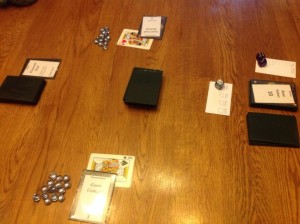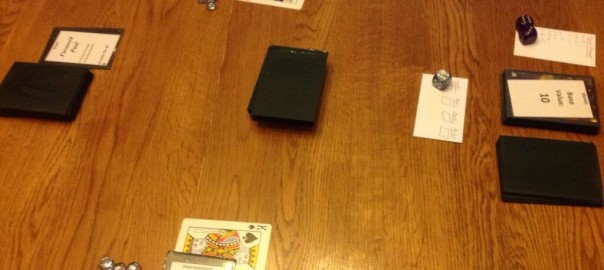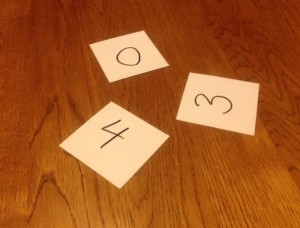In chapter 1 of this Design Diary, I described the initial idea for my work-in-progress game design, Mansion Builder. It’s an auction game in which players are property developers, bidding in auctions to acquire ridiculous improvements for their mansions in order to satisfy the desire of oddball buyers.

One of the first issues I had to deal with: How do I want to actually conduct the auction? It’s a simultaneous auction where everybody decides how much they want to bid and then everyone reveals their bids at the same time. How did I want this to work at the table?
Well, as a designer I had a few different approaches for running simultaneous bid auctions.
Auction cards
My first thought (since it was at hand) was to go with cards. Specifically, I used regular playing cards and gave each player a set of Ace (representing 1) through 10 of a suit. When it was time to bid, everyone would choose one of their cards, put it face down in front of them, and then everyone would reveal simultaneously.
This actually did work, but it had some drawbacks.
First, it limited the players to bidding up to 10. In theory, if a player has 25 money and they want to bid all of it, they should be allowed to.
Second, it created an awful lot of components. A full set of bidding cards for each player is unwieldy.
Third, if the game were played a lot, these cards would wear unevenly. The lower numbers (5 or less) would be used the most, and could end up being marked.
Dry-erase cards
My next idea was to give each player a card with a dry-erase coating on it, along with a dry-erase marker (think Telestrations, but smaller). Everyone secretly writes their bids, then reveals simultaneously.
This worked okay in practice, but I still wasn’t completely happy with it.
First, depending on how sneaky players were being, it could be possible to figure out what others were writing based on the movement of their pen.
Second, it was a little bit messy with all of the dust from erasing the bids.
Closed hands
My current approach is making me happy so far. Money in the game is represented by small tokens of some sort. I’m currently using small plastic “scatter” that looks like little crystals. The clear crystals are worth 1 money each, and the amber crystals are worth 5.
Players put whatever quantity of money they want to bid in a closed fist, then all players simultaneously open their hands to reveal their bids.
The biggest advantage of this approach is that it’s a lot of fun. There’s a nice moment of tension when all of the players have a closed fist in the middle of the table right before the bids are revealed.
Another advantage is that it makes bookkeeping much easier. I always had tokens for money, and with the other methods the players had to reveal their bids, then reach into their supplies to fish out the right amount of money and put it back in the bank. Now they can just drop the crystals that are in their hands right into the bank pile.
End of chapter 2
So, that’s one issue solved: Closed fist auctions are going to work for Mansion Builder. Next time, I’ll talk about the challenges of designing useful playtest cards. Icons ahoy!
Michael Iachini – Clay Crucible Games



